How To Grow Strawberries
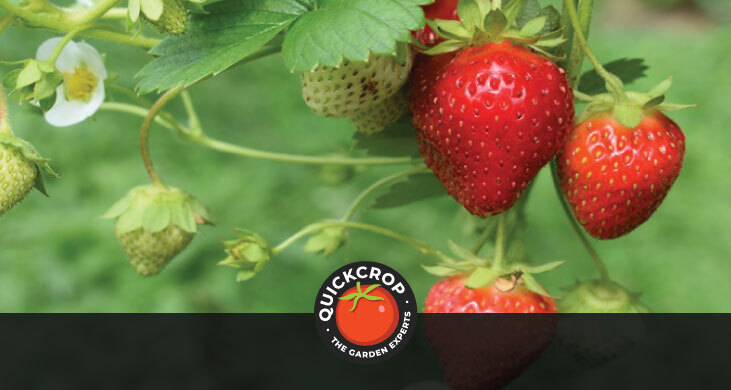
Fruit trees and bushes are planted in the garden with the intention of being around for the long haul, providing harvests for many years. In return for this supply of fresh fruit they require regular feeding, training, pruning and (in some cases) protection from harsh winter weather.
However, the most prolific, dependable and easiest fruit to cultivate is the strawberry. Strawberries do not require much attention, and they provide great-tasting harvests for very little effort.

Strawberry & Herb Planters -2 Pack
View ProductThese juicy, refreshing fruits can be grown practically anywhere, and are well suited to borders, hanging baskets and raised beds. They are ideal for urban gardeners working with limited space, community and school gardening projects, or beginners who will delight at the flavour of homegrown strawberries versus store-bought packets that have travelled long distances.
Protecting Strawberries from Frost
Frost is the first thought when considering where to grow strawberry plants in your garden. They are very hardy plants during the winter, but are not so hardy when they burst into life in spring.

Easy Fleece Tunnels - Garden Cloches
View ProductStrawberries produce flowers early in the spring, and because they are close to the ground it is important to position strawberries where they have the least risk of frost. The highest ground is always the best. When they first start into growth, frost damage will occur if the temperature drops below -2°C or -4°C without cloche or polytunnel protection.
Soil Preparation
Strawberries do not produce deep roots, but they very much appreciate their soil being well dug to a spade's depth. Prepare the soil at least one month before planting. Incorporate as much organic matter as possible, and include two handfuls of bonemeal per square metre (yard).
When to Plant Strawberries
Young strawberries should be planted in autumn or late spring in a sunny position. Plant in well manured, free-draining soil or multipurpose compost. The site should be sheltered from wind (which would deter any insects from pollinating).
The roots of each plant should be spread out over a small mound in the soil and back filled, so the crown of the plant is just poking above the surface. They can be grown in rows or clumps, leaving a space of 6”/150mm between plants.
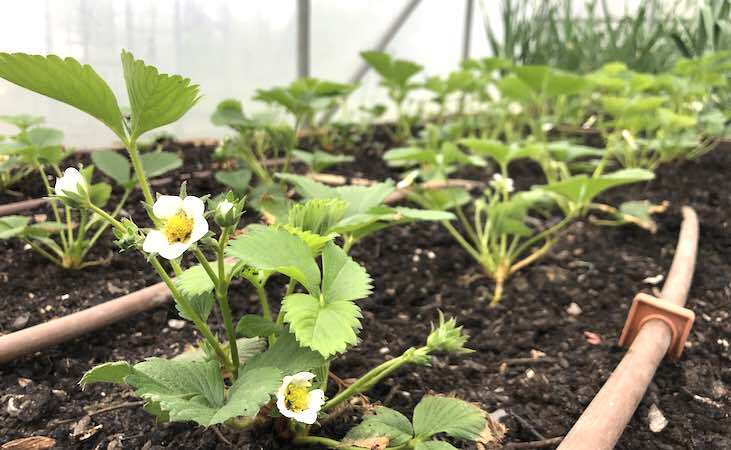
Summer fruiting strawberries like 'Cambridge Favourite', a popular variety, will be ready for picking from June into July. Pots and containers can be placed under cloches or in an unheated greenhouse for an early crop (see the above video for a comparison of indoor strawberries vs grown outdoors).
Feeding Strawberries
A few days before planting, apply the recommended dose of general fertiliser. Strawberries are greedy feeders over a relatively short period of time.
If you are improving the soil in strawberry beds, it is best to do this during the late summer tidy up. Applying a nitrogen rich feed in spring would lead to vigorous leaf growth at the expense of the fruit.
A small white flower grows in spring which eventually develops into the rich red berry. During this growing season, liquid potash feed should be applied weekly to promote healthy fruit development. A mulch (traditionally straw) should be placed on the soil to protect the ripening fruit from the damp compost; it may also help to deter pests and weeds.
As regards summer feeding, avoid excess nitrogen as mentioned above, but use a high potash feed if plants need a boost from flowering time through to harvest: tomato feed is ideal. My own regime is to add seaweed and poultry manure pellets at 150g per square metre in late summer, and leave it at that: a well-fed soil generally doesn't need any extra feed, provided plants are adequately spaced.

Irish Seaweed Tomato and Fruit Feed. 2.5 Litre
View ProductEach strawberry plant generally has a productive life of 3-4 years but will put out runners for propagation the following year.
New plants can be propagated by pinning baby plants growing on runners into a pot of compost and letting them root. After a week or two, the runner can be cut and the pot - now containing a brand new strawberry plant - removed and planted elsewhere.
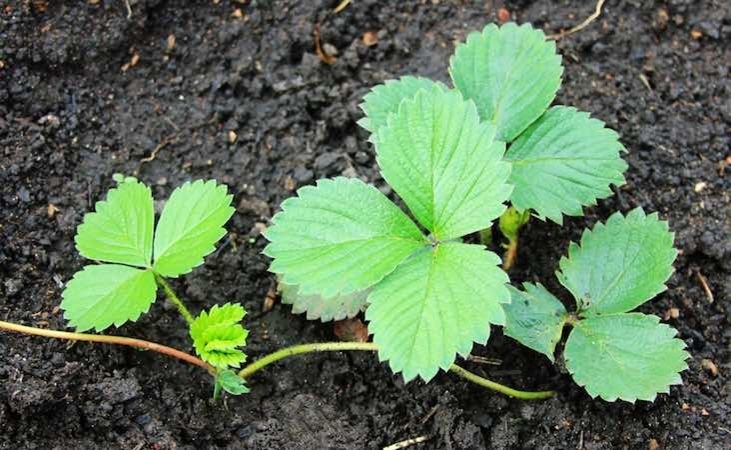
Bear in mind that strawberry plants will decline in productivity after about 3 years. You should continually replace any older, tired looking plants with fresh ones to keep your strawberry patch producing decent sized fruit.
An overcrowded strawberry bed will also result in smaller fruit, as plants compete for water and nutrients - so you should aim to keep your spacings around the same as they were when you planted them, i.e. 45cm apart in rows 75cm apart. Strawberries are tough, so don't be concerned about digging them up and moving them. Just make sure you re-plant the healthiest looking plants.
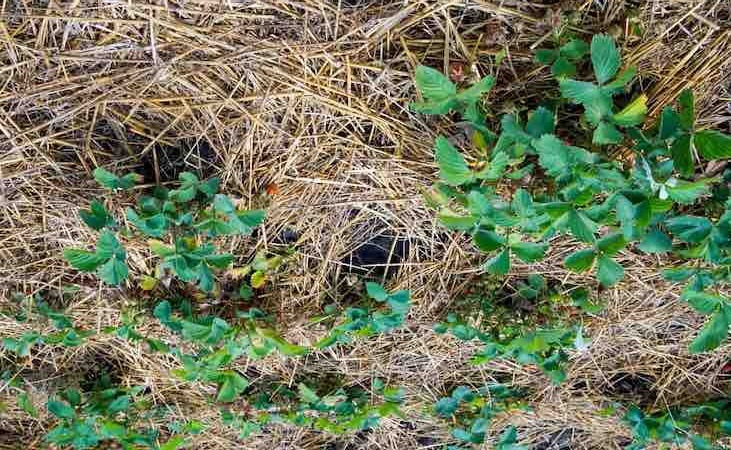
Strawberry Plant Care
As the fruit begins to develop, their weight will cause them to lay on the ground. Before this happens (but no earlier than necessary), cover the soil around the plants with either straw or black plastic. Where plastic is used, it can be kept in place with stones; small holes should be made in the plastic to allow drainage and to stop water collecting. The plastic or straw will prevent the fruits from lying directly on the soil, which will rot them.
If you have a bird population in your garden, the plants should be protected (when the fruits begin to swell) with lightweight plastic netting. This should be held clear of the plants by tying it to short wooden posts and securing the netting to them. Wire mesh can also be used, held in place by canes at either corner. A more permanent and effective solution to bird damage is a fruit cage, which is suitable for many other fruit plants as well.

Butterfly and Bird Netting 10m x 2m - 7mm x 7mm Mesh
View ProductStrawberries will naturally die back in winter, but there is no need to trim leaves off unless you want to tidy up for aesthetic reasons.
Leaving a mat of dead or dying leaves will help protect the soil over winter. The only downside is that you may be creating habitats for slugs - but the beds should be cleaned in late winter/early spring anyway, when any unwelcome residents can be removed.
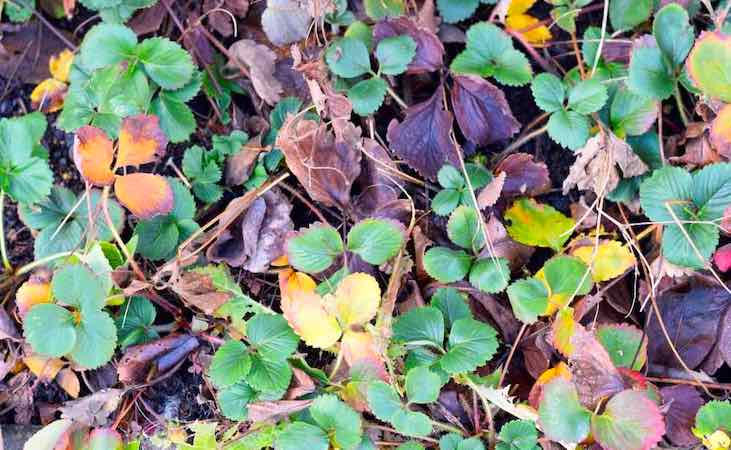
The best time to tidy up strawberry beds and to propagate new plants is just after the fruiting season (around mid-July). They will also benefit from some attention before the growth starts again in early spring. In late summer you can remove any dead or weak looking plants; cut back older leaves on healthy plants to 3 inches above the crown, leaving the new leaves in place.
In late winter and early spring you can attend to any tidying jobs required, including any of the above (apart from propagation). I would hold off mulching plants with straw, as is often recommended, until the fruit has set and started to swell. The mulch's primary function is to keep fruit off damp soil, so it's better to add a fresh mulch when needed rather than letting it rot down and/or provide a slug habitat.
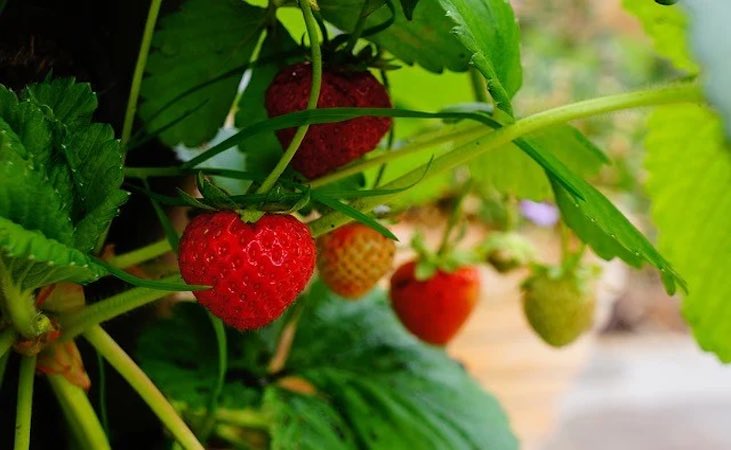
When to Harvest Strawberries
The strawberries are ready to be harvested when the fruit is red and shiny, but daily inspections should be made in order to pick the tasty berry before birds and slugs arrive.
Strawberries - Diseases and Pests
The major pests and diseases of strawberries are aphids, red spider mite, slugs, powdery mildew and botryitis.
